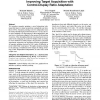Free Online Productivity Tools
i2Speak
i2Symbol
i2OCR
iTex2Img
iWeb2Print
iWeb2Shot
i2Type
iPdf2Split
iPdf2Merge
i2Bopomofo
i2Arabic
i2Style
i2Image
i2PDF
iLatex2Rtf
Sci2ools
CHI
2004
ACM
2004
ACM
Semantic pointing: improving target acquisition with control-display ratio adaptation
We introduce semantic pointing, a novel interaction technique that improves target acquisition in graphical user interfaces (GUIs). Semantic pointing uses two independent sizes for each potential target presented to the user: one size in motor space adapted to its importance for the manipulation, and one size in visual space adapted to the amount of information it conveys. This decoupling between visual and motor size is achieved by changing the control-to-display ratio according to cursor distance to nearby targets. We present a controlled experiment supporting our hypothesis that the performance of semantic pointing is given by Fitts' index of difficulty in motor rather than visual space. We apply semantic pointing to the redesign of traditional GUI widgets by taking advantage of the independent manipulation of motor and visual widget sizes. Categories and Subject Descriptors: H.5.2 [Information Interfaces and Presentation (e.g., HCI)]: User Interfaces ? Graphical user interfac...
CHI 2004 | Graphical User Interfaces | Human Computer Interaction | Semantic Pointing | Visual Widget Sizes |
| Added | 01 Dec 2009 |
| Updated | 01 Dec 2009 |
| Type | Conference |
| Year | 2004 |
| Where | CHI |
| Authors | Renaud Blanch, Yves Guiard, Michel Beaudouin-Lafon |
Comments (0)

